Intel Core i7 4960X (Ivy Bridge E) Review
by Anand Lal Shimpi on September 3, 2013 4:10 AM EST- Posted in
- CPUs
- Intel
- Ivy Bridge
- Ivy Bridge-E
Memory Performance
Seeing as how the huge L3 cache and quad-channel memory interface are big parts of what makes Ivy Bridge E unique, I thought it might make sense to look at memory latency and bandwidth. We'll start with memory latency, compared to Ivy Bridge, Haswell and Haswell + Crystalwell.
The larger L3 cache buys IVB-E lower latency accesses for a wider range of addresses, but once you exceed the 15MB L3 cache space we see latency about on par with everything else. Only Haswell + Crystalwell manages to hold out for longer. Unfortunately that's not really a part desktop enthusiasts can buy so it's mostly an academic comparison.
The bandwidth story is an interesting one. Sandra maxes out bandwidth by driving all cores at the same time, so you get some uplift here by there simply being more cores under IVB-E's hood. But even if you divide out the number of cores, you get per core cache bandwidth figures that are extremely high (at least outside of L1). The L3 cache in particular is quite bandwidth happy.
Going outside of the L3 cache, we also see a doubling of memory bandwidth - which is expected given the doubling of memory interface width. In reality the peak memory bandwidth advantage would be even larger as IVB-E officially supports DDR3-1866 (if you only populate 1 DIMM per channel, otherwise either 1333 or 1600 is officially supported).
General Performance
I don't know that I've ever seen an Intel slide before that called out a performance degradation, but there's a first time for everything:
The problem with IVB-E vs. Haswell is that the extra large L3 cache and quad-channel memory interface are generally only useful in heavily threaded applications, which of course benefit from its 6-core configuration. In those tests that aren't heavily threaded however, IVB-E typically sees a single threaded performance deficit compared to Haswell. Given that the 4960X and Haswell based Core i7-4770K run at very similar frequencies, it's not surprising to see IVB-E take a backseat to Haswell in in "everyday computing" tasks. Intel's slide above claims about a 18% reduction in "everyday computing" performance compared to the 4770K, but in practice I found the gap to be much narrower.
Although not the best indication of overall system performance, the SYSMark 2012 suite does give us a good idea of lighter workloads than we're used to testing.
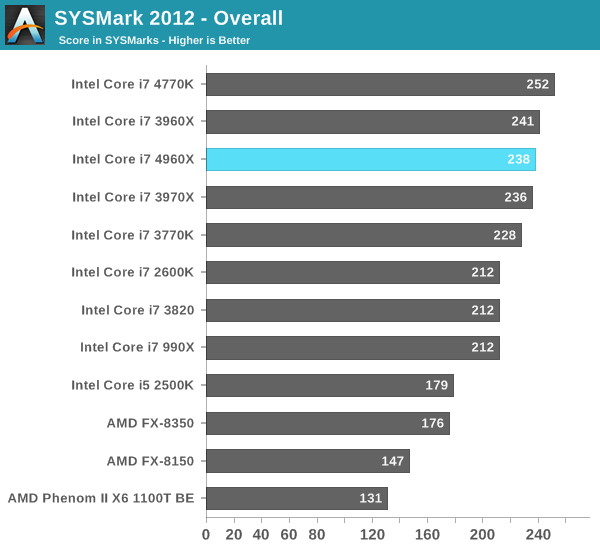
There's pretty much no advantage to the 4960X over the 3970X here. Remember Ivy Bridge's architectural improvements were very limited on the CPU side. As clock speeds didn't really go up between the 3970X and 4960X, the performance parity here isn't surprising. Haswell manages a ~6% performance advantage over the 4960X at an obviously lower power and price point.
Although I retired SYSMark 2007 a while ago, I do have much older performance data here which lets us compare the 4960X back as far as the early Pentium 4 based Extreme Edition parts:
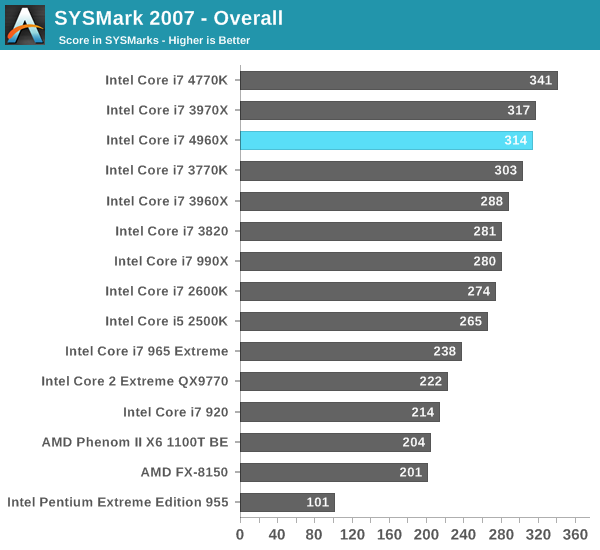
The Haswell advantage grows a bit here to around 8%, but the 4960X remains in the top three performers here. It's very clear that for most users, there are far more cost effective ways of getting great performance than IVB-E.
Our final lightly threaded test is Mozilla's Kraken JavaScript benchmark. This test includes some forward looking js code designed to showcase performance of future rich web applications on today's software and hardware. We run the test under IE10:
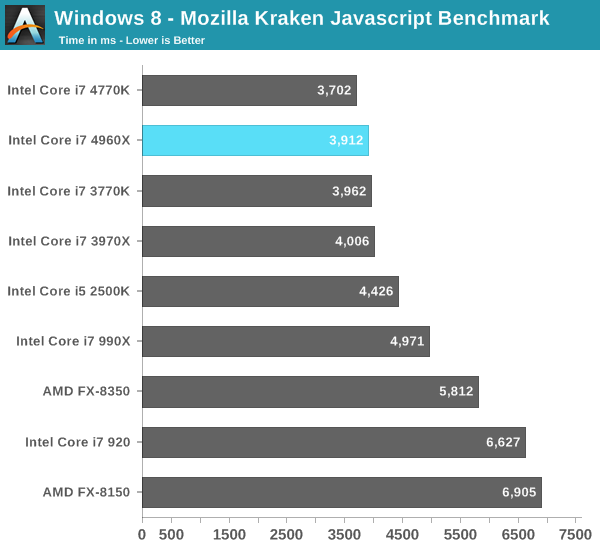
Ivy Bridge always had good single threaded performance, but once again these lightly threaded use cases are better served by an architecture with higher IPC. The Haswell advantage isn't huge, but it's a lower power/more cost effective way to get the best performance here.
If you are still on LGA-1366, you'll note that the performance gains here are good, but not earth shattering. Comparing to Intel's first 6-core platform, the 4960X manages a 27% increase in performance over the Core i7-990X. That's a healthy gain, but it's still small enough where there's no immediate need to upgrade.


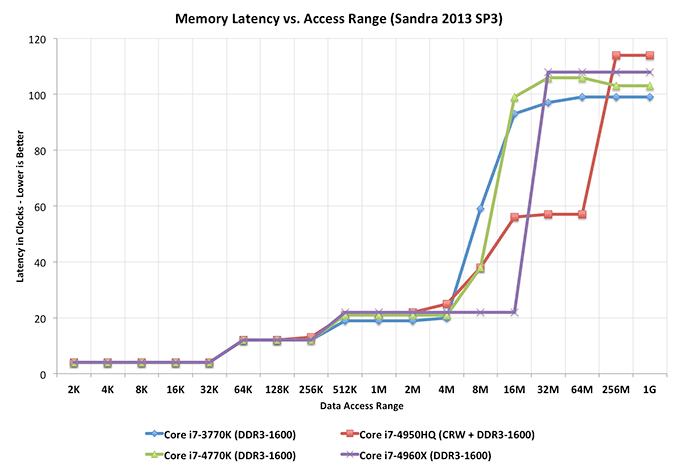
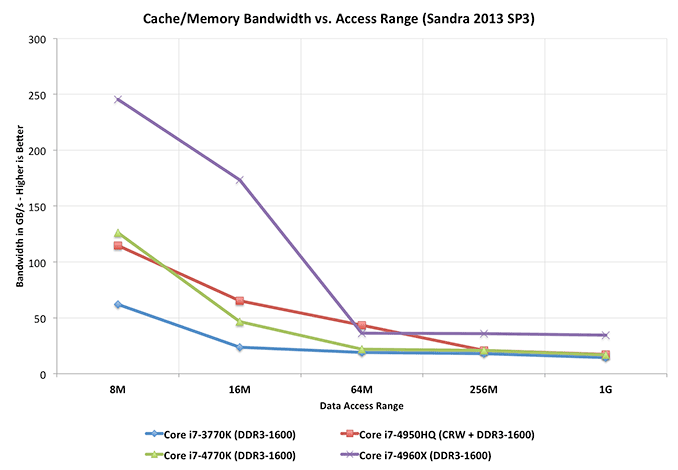
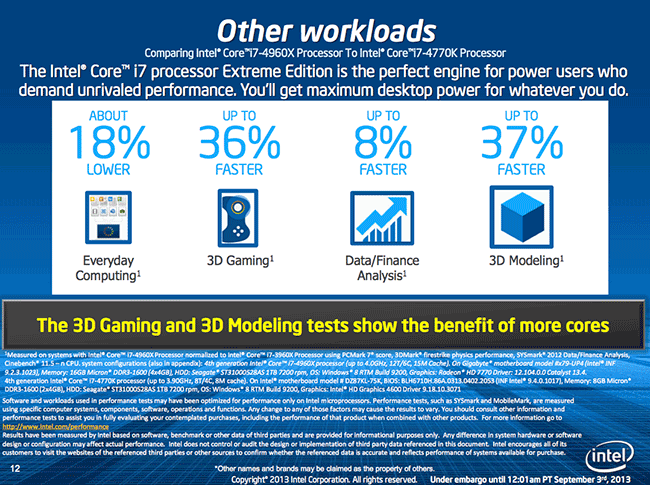








120 Comments
View All Comments
chadwilson - Tuesday, September 3, 2013 - link
Is the IHS soldered or using the cheap termal material? The issue with desktop IB & Haswell overclockability has been proven to be the cheap thermal material between the chip and IHS. If they have a soldered chip to IHS then this will be a decent upgrade over straight IB.BrightCandle - Tuesday, September 3, 2013 - link
Considering the power consumption, clock speed, overclock and temperature obtained its looking most like this is the same interface as SB-E - ie its soldered. Not that it makes much difference as just like SB-E it doesn't actually overclock all that well compared to its 4 core sibling.MrSpadge - Tuesday, September 3, 2013 - link
Look at the results: temperature is not the main problem any more due to the bigger die, but OC is still not good at 4.3 GHz / 1.4 V. Actually I'd say this is ridiculously bad compared to earlier 22 nm chips (my Ivy can do this at ~1.1 V).And I recently got a 3770K which requires 1.11 V to even hit 4.0 GHz! Seems to me Intels current process is to blame for Haswell OC rather than the thermal paste. Sure, temps drop when replacing the paste.. but OC doesn't improve all that much, does it? And if Ivy and Ivy-E don't clock all that well either...
Shadowmaster625 - Tuesday, September 3, 2013 - link
If SNB-E @ 435 mm^2 fit into 130W then they could have made IVB-E @ 435 mm^2 fit into about the same power envelope. If they had to drop the clocks a couple hundred MHz then that's a small price to pay for 10 cores.Kevin G - Wednesday, September 4, 2013 - link
Actually, the core count for the larger Ivy Bridge-E goes up to 12.adamantinepiggy - Tuesday, September 3, 2013 - link
So do these CPU use actual solder under the lid or crappy paste like the 4770K?noeldillabough - Tuesday, September 3, 2013 - link
Oh I've waiting for this! Now the most important question to me...which motherboard is everyone getting an Ivy Bridge-E going to use? I'm doing a custom water cooled loop if that makes any difference.diceman2037 - Tuesday, September 3, 2013 - link
Anand, that marketing image is suffering from a typo, "18% Lower" refers to power utilized, not performance.DMCalloway - Tuesday, September 3, 2013 - link
Wow! 40 PCIe lanes sounds great until you remember skt. 2011 still only supports two 'true' sata3 ports and no native usb3. PCIe storage is never a smooth experience. It's a shame Intel seems unconcerned with power users that are not enterprised based.randfee - Tuesday, September 3, 2013 - link
What a shame these don't support ECC memory! I want it back for the enthusiast!I'm a scientist, what am I supposed to purchase (privately)? I want a beefy machine for physics simulations at home that run for days/weeks i.e. What if a privat person wants to run several VMs?
The E-series would provide nice performance, but no ECC, what a shame!
Right now one has to pick between speed without ECC (chances are the crashes on you) or a chip with relatively slow performance (clock wise) to get ECC, at the same price point. The highend XEON CPUs are out of the question.
@ Anand, please point out to the Intel representatives you meet that there's a market for this! One has to consider AMD at this point, they offer many threads + ECC for a consumer price point. Granted, they're slower, but the premium for the Intel chips with ECC is just out of proportion for private use.